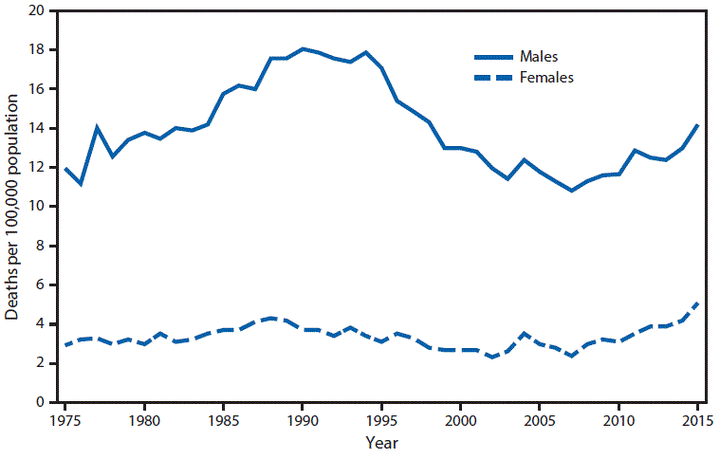
The suicide rates for adolescent boys and girls have been steadily rising since 2007, according to a new report from the U.S. Centers for Disease Control and Prevention.
The suicide rate for girls ages 15 to 19 doubled from 2007 to 2015, when it reached its highest point in 40 years, according to the CDC. The suicide rate for boys ages 15 to 19 increased by 30 percent over the same time period. The analysis looked at data from 1975 to 2015, the most recent year those statistics were available.
The suicide rate for teen boys increased from 12 suicides per 100,000 individuals in 1975 to 18 suicides per 100,000 people in 1990, when it reached its highest point. The numbers then declined from 1990 to 2007 and then climbed again by 2015.
The suicide rate for teen girls was lower than for teen boys, but also followed a similar pattern ― increasing, then declining, then sharply spiking by 2015.
“In 1975, in the United States, there were 1,289 suicides among males and 305 suicides among females aged 15 to 19 years,” the authors wrote. “In 2015, there were 1,537 suicides among males and 524 among females aged 15 to 19 years.”

The numbers are an alarming reminder that suicide is a growing public health problem. Last year, the CDC released a separate report that found that suicides for the U.S. population as a whole increased 24 percent over a 15-year period.
Following that report, experts expressed concern over the suicide rate increase in young women ages 10 to 14, noting that demographic is one to keep an eye on.
The numbers are also further proof that teens are an increasingly vulnerable group when it comes to mental health. Research shows that teen depression rates are on the rise, yet stigma or fear of asking for help often prevents people from getting medical support. Untreated mental health conditions are among the leading causes of suicide.
Experts say there are multiple reasons more young people are struggling with their mental health. Heavy social media use, bullying, economic burdens, family issues and exposure to violence can all be risk factors for conditions like depression, according to Dan Reidenberg, executive director of the Suicide Awareness Voices of Education.
“People often think that teens can’t get depressed or anxious, but they can. People also often think that it is ‘just normal teen angst,’” Reidenberg told HuffPost. “While the teen brain is still developing, teens do struggle with genuine mental illnesses and they need to be properly evaluated and treated.”
Reidenberg, who was not associated with the CDC analysis, says the new report should be a wake-up call to everyone. He hopes it encourages more people to start talking about mental health from a younger age.
“We need to make it okay to talk about things that are causing emotional pain and let people know that it is real, but it can get better,” he said. “We should be concerned, because dying by suicide shouldn’t be an option, and young people often feel like it is their only option.”
Most importantly, Reidenberg stressed, there needs to be more encouragement for people to seek medical care. Uncharacteristic changes in behavior, fluctuations in academic performance and withdrawal are all signs something bigger could be occurring, Reidenberg said.
“We need to change perceptions to help teens learn it is okay to ask for and get help,” he added.
If you or someone you know needs help, call 1-800-273-8255 for the National Suicide Prevention Lifeline. You can also text HELLO to 741-741 for free, 24-hour support from the Crisis Text Line. Outside of the U.S., please visit the International Association for Suicide Prevention for a database of resources.